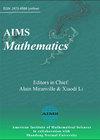Classical and Bayesian inferences on the stress-strength reliability $ {R = P[Y < X < Z]} $ in the geometric distribution setting
IF 1.8
3区 数学
Q1 MATHEMATICS
引用次数: 0
Abstract
The subject matter described herein includes the analysis of the stress-strength reliability of the system, in which the discrete strength of the system is impacted by two random discrete stresses. The reliability function of such systems is denoted by $ R = P[Y < X < Z] $, where $ X $ is the strength of the system and $ Y $ and $ Z $ are the stresses. We look at how $ X $, $ Y $ and $ Z $ fit into a well-known discrete distribution known as the geometric distribution. The stress-strength reliability of this form is not widely studied in the current literature, and research in this area has only considered the scenario when the strength and stress variables follow a continuous distribution, although it is essentially nil in the case of discrete stress and strength. There are numerous applications wherein a system is exposed to external stress, and its functionality depends on whether its intrinsic physical strength falls within specific stress limits. Furthermore, the continuous measurement of stress and strength variables presents inherent difficulties and inconveniences in such scenarios. For the suggested distribution, we obtain the maximum likelihood estimate of the variable $ R $, as well as its asymptotic distribution and confidence interval. Additionally, in the classical setup, we find the boot-p and boot-t confidence intervals for $ R $. In the Bayesian setup, we utilize the widely recognized Markov Chain Monte Carlo technique and the Lindley approximation method to find the Bayes estimate of $ R $ under the squared error loss function. A Monte Carlo simulation study and real data analysis are demonstrated to show the applicability of the suggested model in the real world.几何分布下应力-强度可靠度$ {R = P[Y < X < Z]} $的经典和贝叶斯推断
本文描述的主题包括系统的应力-强度可靠度分析,其中系统的离散强度受到两个随机的离散应力的影响。用R = P[Y < X < Z] $表示系统的可靠性函数,其中$ X $为系统的强度,$ Y $和$ Z $为应力。我们看看X $, Y $和Z $是如何符合一个众所周知的离散分布,即几何分布的。目前文献中对这种形式的应力-强度可靠度的研究并不广泛,而且该领域的研究只考虑了强度和应力变量服从连续分布的情况,而在应力和强度离散的情况下基本没有研究。在许多应用中,系统暴露于外部应力,其功能取决于其内在物理强度是否落在特定的应力范围内。此外,在这种情况下,连续测量应力和强度变量存在固有的困难和不便。对于建议的分布,我们得到了变量$ R $的极大似然估计,以及它的渐近分布和置信区间。此外,在经典设置中,我们找到了$ R $的启动-p和启动-t置信区间。在贝叶斯设置中,我们利用广泛认可的马尔可夫链蒙特卡罗技术和林德利近似方法来寻找平方误差损失函数下的R $的贝叶斯估计。通过蒙特卡罗仿真研究和实际数据分析,证明了该模型在现实世界中的适用性。
本文章由计算机程序翻译,如有差异,请以英文原文为准。
求助全文
约1分钟内获得全文
求助全文
来源期刊

AIMS Mathematics
Mathematics-General Mathematics
CiteScore
3.40
自引率
13.60%
发文量
769
审稿时长
90 days
期刊介绍:
AIMS Mathematics is an international Open Access journal devoted to publishing peer-reviewed, high quality, original papers in all fields of mathematics. We publish the following article types: original research articles, reviews, editorials, letters, and conference reports.
 求助内容:
求助内容: 应助结果提醒方式:
应助结果提醒方式:


